
Books for Anzac Day (first blog post containing seventeen books can be found on the Reading Opens Doors blog here).
One way for children to learn about Anzac day, in a way that is accessible for them is through books that sensitively tell stories about the men and women who served – stories about their experiences on the battlefield, the family they left behind and what it was like when they returned home. There are several books that have been written for a younger audience which include fascinating first hand accounts from various wars. These sources of information are woven seamlessly into engaging stories to provide valuable insight into the realities of war. Some engaging books which are excellent to read in preparation for Anzac day and deserve to be in any collection relating to Anzac Day include:

A detailed review for Australia Remembers Len Waters: Boundless and Born to Fly has been written in an earlier Reading Opens Doors blog post here.
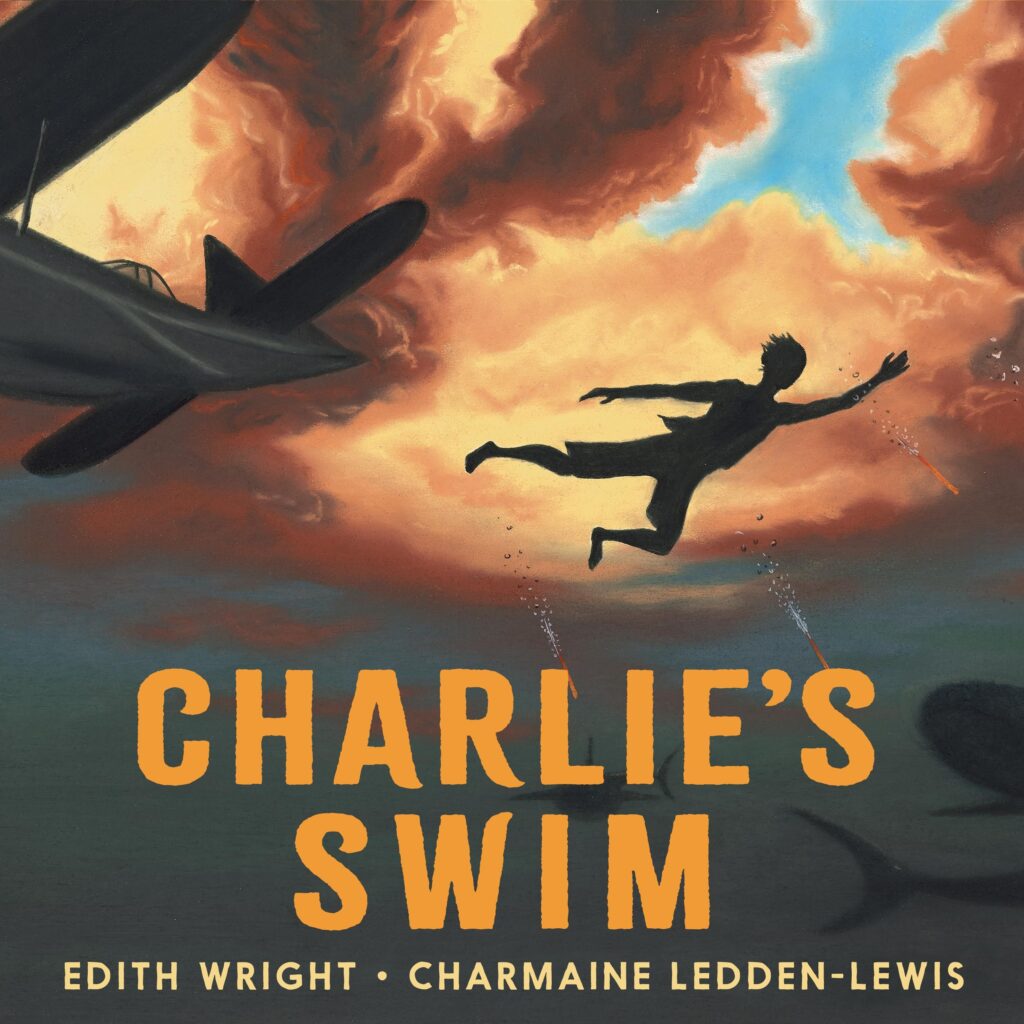
A detailed review for Charlie’s Swim has been written in an earlier Reading Opens Doors blog post here.

This Old Thing written by Cassandra Webb and illustrated by Tony Flowers is a moving book about memories, war, stories and remembering the past.
Tony Flowers always uses the endpapers as an opportunity to begin the narrative, divulge more about the story and stir readers’ curiosity. In this book, he has included different sets of collections of objects from World War I on the front and back endpapers. All these fascinating objects either feature in the book or are objects Tony discovered in his extensive research process. Tony has comprehensive illustration notes available (link at end of review) and included in these are the list of items on the endpapers.
This story is told in two different time periods concurrently– present day and during World War 1. The story features a young boy who appears through most of the story on the left-hand page, right until the very last moving page. The young boy represents present day as he is searching through his great grandfather’s army trunk and discovering old things from long ago. On the right-hand pages, the objects the boy finds are given context as they appear with the great grandfather during scenes from World War 1. These meticulously researched and historically accurate scenes immerse the reader into the world of the great grandfather serving in Europe in World War I.
In this story, Anzac Day is approaching and the boy is on a mission to find something old to help his class remember. He decides to explore the contents of his great grandfather’s army trunk and the objects he discovers provide clues about the past as these objects have a story, a story from World War I. The boy finds service papers and on the right-hand page the reader sees men getting measured and having medical examinations prior to serving in the war. A World War 1 recruitment poster is also featured and gives an insight into the government’s message for men to support the war effort. The story continues with objects such as a slouch hat worn by his great grandfather and an illustration shows the harsh climate the hat was worn in; a mug is then extracted from the trunk, another clue, another piece of the puzzle from the past. The story behind the mug reveals the great grandfather in an active trench having a drink with his comrades. The story continues with recreational objects the soldiers used pulled from the trunk, for example playing cards. Then a photo of a man and dog is discovered, not very interesting to the boy, but then the bigger picture on the right page is illustrated, the history, the story behind the photo where the reader sees the great grandfather with a service dog and the artillery unit. More primary sources are removed from the trunk and more history unfolds about the great grandfather as the reader learns about tank warfare and gas masks. All of these forgotten objects stored in the trunk have little significance, until together, they form clues from the past and a photo ties everything together, bringing to life the past. Faded memories are now brought to the boy’s attention and his great grandfather’s story lives on.
This book is an excellent resource as a gateway to conversations about primary sources from the past and how these treasures inform people today about history. Tony Flowers was inspired by official war artist, Albert Henry Fullwood, who was commissioned to join the war in Europe to capture the Australian experience, thus the illustrations in this story provide another dimension and visual perspective to the war. There are stories to be unpacked within each illustration. Children can use these illustrations to conduct further inquiry into the conditions and life for the Australian soldiers during World War I, both in battle and during rest and recreation. On a personal level, children may be able to learn about their great grandparents and other family members through objects from the past. Link to the illustration notes by Tony Flowers: https://www.academia.edu/73882761/This_Old_Thing_Illustration_Notes_March
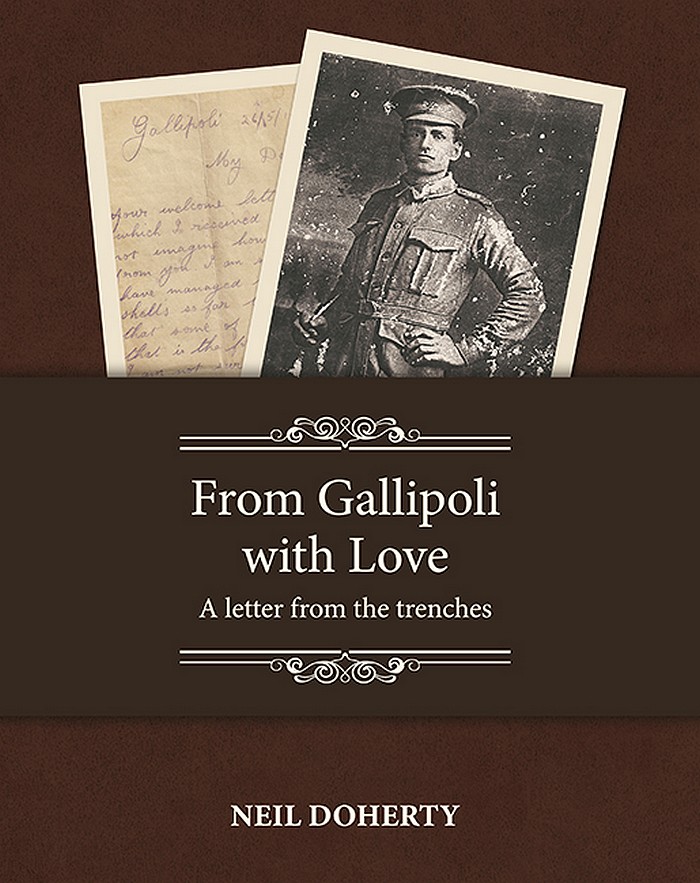
From Gallipoli with Love, A Letter from the Trenches by Neil Doherty, illustrated by Catherine Ladewig and published by Boolarong Press is a deeply personal family account as the text in this picture book contains the words of the final letter by Private Michael Lobwein, (Mick), the author’s Grand Uncle sent to his sister, (the author’s Grandmother) while serving in World War I. In the brief and informative introduction the reader learns that this letter was written in the trenches of Gallipoli in 1915 after Mick had been in combat for one month. Tragically, he died in action three days later at 31 years old. Reading the text with this knowledge stirs many emotions and creates such a visceral response. This primary source provides valuable insights into life for the soldiers, the mateship that existed, the landing at Anzac Cove, the brutal and life threatening conditions associated with trench warfare, the constant shelling, the dangerous and tremendous obstacles the stretcher-bearers navigated, the indiscriminate loss of life, as well as a personal insight into Mick’s character. A copy of the four page hand written letter is included in an envelope at the back of the book.
The letter, dated 26 May 1915, makes mention of Mick’s concern about his letter passing the censor and he goes onto say that he is unable to say too much. However, much information can be deduced from this firsthand account. The reader learns that wile approaching Anzac Cove in open boats and under heavy attack, one of the diggers was hit by a bullet, but escaped injury as the bullet lodged in his badge on his collar. Mick explains that he went without showering or removing his boots for the first ten days as the intense fighting was all consuming and there was no time for such things. He recounts his first two unfathomably brutal nights. The first night involved trench digging and being a stretcher bearer, a particularly treacherous, gruelling and confronting job which brought into sharp focus the impact of the enemy attacks. On the second night, Mick found himself in the cold, out of the trench as there was not enough room for all of the soldiers. He spent the night furiously digging a trench, all while bullets were raining down all around the soldiers and acutely aware that the Turks were advancing. Morning brought him a sense of gratitude that he had persevered and dug throughout the night as the new day saw them bombarded with shrapnel. The trench provided safety and he believed saved his life. This was where he stayed for two days, only to be relocated to another trench where rest eluded him and any small amount of sleep the men had was done standing up. Here the men were instructed to maintain continual fire. Mick’s rifle became so hot he was unable to physically touch it and the woodwork began to burn. He had three rifles on rotation to carry out the military orders to continually keep firing. He also shares the physical toll and injuries he sustained while constantly firing.
The illustrations bring Mick’s letter to life and add to the text as historically accurate details are included in the scenes from the battlefield. The illustrations give the reader a visual perspective of World War 1. Various design principles (such as the use of some silhouettes, framing, size and shape variation) are used to communicate and highlight Mick’s experiences which add to the visual interest and appeal of this picture book.
This is an important book to add to any Anzac collection as Mick’s raw and deeply moving letter highlights the conditions, courage and sacrifices the soldiers made as they fought for their lives and Australia.
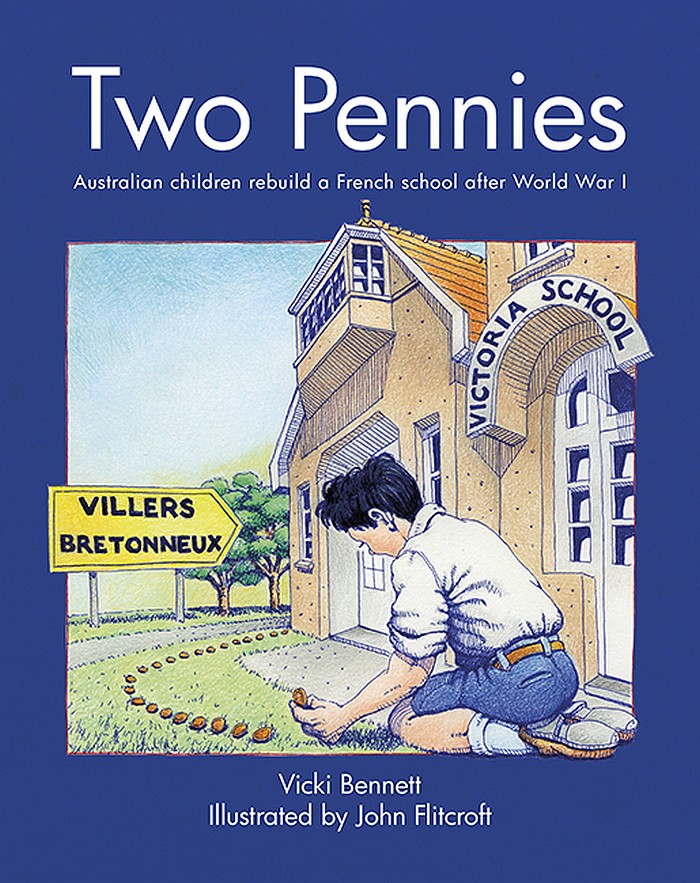
Two Pennies by Vicki Bennett, illustrated by John Flitcroft and published by Boolarong Press is a deeply personal book by Vicki Bennett as it tells the inspiring story of her father, Henry George Mc Gregor, known as George, who while in primary school in Victoria, Australia, formed a lifelong connection with Villers-Bretonneux, France, as he was committed to helping rebuild the school there after it had been destroyed in 1918 during World War I.
This is a story of hope, determination, working selflessly to help others, the power of people working together for the common good and the ripple effect of kindness.
This story begins when George was a young boy living above their family bakery while his father was serving in the First World War. On his father’s return, George learned from his dad about the devastation and utter loss that many French villages had suffered. The homes, shops, buildings, church and village school were all destroyed and now mostly rubble.
George felt such empathy for the children in France and knew it was a terrible loss for them. An opportunity presented at school where George had a chance to make a difference. His headmaster announced that they were going to raise money to help rebuild the Villers-Bretonneux school and a goal was set. It was determined that if each child contributed two pennies this would enable the school in France to rebuild.
George was determined to do his part. He worked in his family’s bakery by tending to the horses that were used to pull the carts to deliver the bread. This meant very early mornings for young George and he became extremely disciplined and dedicated to ensuring the horses were in peak condition. He was determined to earn his two pennies and was unwavering in his commitment. George acted with many other school children all across Victoria to help raise funds to rebuild the school in France (this became known as the Penny Drive).
Together, the children raised enough money to rebuild the school which was named The Victoria School, the name selected to honour the children in Victoria, Australia, who donated the money to build it.
George continued to work and earn more pennies which he saved. At a young age he had a dream to visit the school he helped rebuild. After the war, jobs and food were scarce, a trip to France was out of the question. However, this dream never dimmed and kept flickering away in George’s heart until in 1982 he wrote to the Mayor in Villers-Bretonneux to request a visit with his wife. George was welcomed with fanfare and had a personal tour of the school with the Mayor.
In George’s final years he had one more kind act that he wanted to carry out, but was too unwell. So, he asked his daughter, Vicki (the author of this book) to take two pennies he had raised when he was a young boy to the Victoria School on his behalf. The precious pennies are now displayed at the French-Australian museum in Villers-Bretonneux, which was freed from German forces in 1918 at the cost of more than 1200 Australian lives.
John Flitcroft employs a retro colour palette for the illustrations which help create a vintage feel and reflect the era the illustrations depict. The illustrations bring the story to life and detail aspects of Australian society at the time.
In recent times, children may have seen communities working together to help others and make a substantial difference to others, whether it be volunteers assisting people in the recent floods, or children from all around the globe writing to the young people in Ukraine as a sign of solidarity. It is vital that children are exposed to empowering stories where they see and come to know that a community can do much good and certainly make a difference.
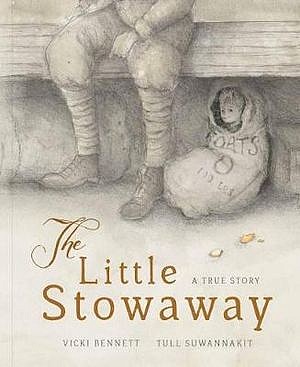
The Little Stowaway by Vicki Bennett and illustrated by Tull Suwannakit tells the true story of a young orphaned French boy, Honoré, while wandering on a bitterly cold night was attracted to the aromas of food wafting from an Australian army camp during World War I. On his arrival, Honoré was warmly greeted by Tim, an Australian airman who generously shared some of the Christmas meal the soldiers were enjoying inside the hut. This is the beginning of an unbreakable bond and a story of courage, compassion, survival and family.
Tim teaches Honoré some new and exciting skills and as the friendship developed Tim gives Honoré the name, Young Digger. Honoré was keen to help the soldiers and an opportunity presented that required rats to be caught. The young boy showed such initiative and this relutled in him up being an excellent rat catcher for the Australian Flying Corps.
Tim returned with Honoré to his home town of Lille to look for members from his family. After learning that it was not possible to locate any surviving relatives, Tim assured Honoré that he would now be his family. Tim shares a photo of his family with Honoré and writes to his wife telling her that he wants to adopt Honoré.
When news spread that the war ended, Tim organised for Honoré ‘s journey to Australia as a stowaway to ensure he was not sent to an orphanage. He smuggled Honoré onboard a ship in an oat bag. This was no easy feat and involved Honoré having to be vey quiet and still in an uncomfortable oat bag (made even more so, as items were tied to Honoré to act as a camouflage and disguise his human shape) to avoid arousing any suspicion and being detected. Honoré had a positive mindset and distracted himself with comforting thoughts about life in Australia and Australian animals.
After a long journey, Tim and Honoré arrived in Australia. When they descend from the train they were welcomed home and Honoré was warmly welcomed into his Australian family.
Tull Suwannakit’s has seamlessly included photographs from the time in her illustrations where an understated colour palette was used. The illustrations deftly capture the unwavering hope Honoré felt, despite all the loss that he experienced.
Be sure to read the particularly poignant dedication in this story which also discusses the photos used in the book.
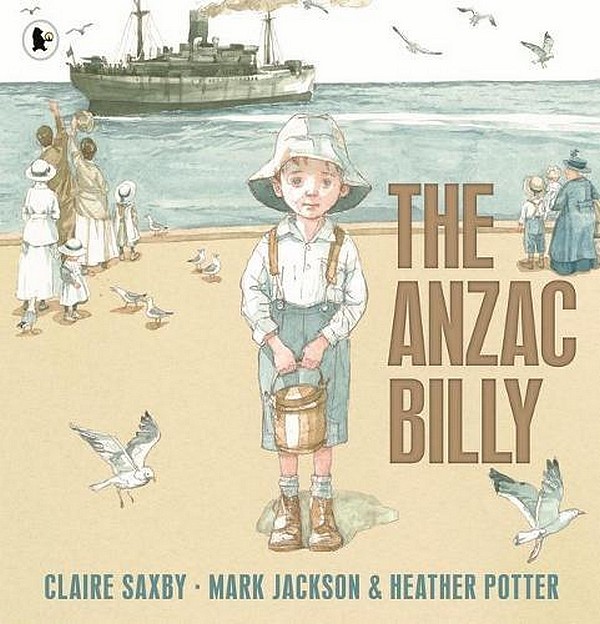
The Anzac Billy by Claire Saxby and illustrated by Mark Jackson and Heather Potter is a meticulously researched picture book inspired by true events whereby families (in Australia and New Zealand) filled billy’s with gifts for Christmas and these were shipped to Australian and New Zealand soldiers serving in World War I.
In this tender story Christmas is approaching and the reader is drawn into the home of a young boy who is “filling a billy full of Christmas”. His Mum, Nanna and baby sister are watching on. Each new day sees the boy add an additional item to the billy, all of these gifts are carefully and thoughtfully considered. The boy chooses a selection of foods for specific reasons as well as a pair of socks. At the end of the week his Mum also adds items to the billy, she selects three practical items for her husband to use. The young boy adds a touching note. With a little space remaining, Nanna added some personal and useful items too.
The billies are packed into boxes and then moved onto the ship to sail the seas to the soldiers. The young boy is aware that his billy may not be given to his Dad and has made a special request in his letter if his billy should be gifted to another soldier.
The very detailed illustrations add to the story and provide so much additional historically accurate information from a bygone era and are brimming with nostalgia. From the first double page spread, I felt like I was sitting opposite the boy, at their dining table in their kitchen. Readers will enjoy pouring over the illustrations detecting the similarities and differences about the home and lifestyle now compared to over 100 years ago in 1915. These beautiful illustrations serve as an excellent gateway to studying this time in Australian history.
This book would be an invaluable addition to any collection of books for Anzac Day.
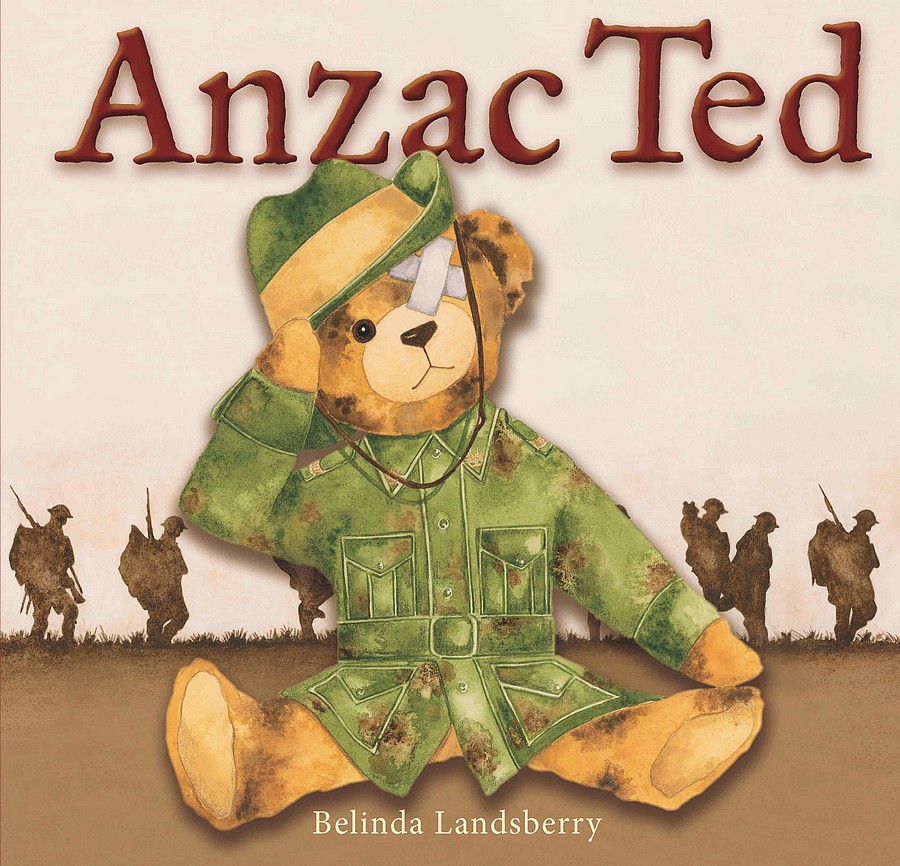
Anzac Ted by Belinda Landsberry is inspired by the author’s family history and uses a teddy bear to introduce younger readers to themes exploring war, specifically the Anzacs in World War 1, in a highly accessible way.
Anzac Ted is an old, worn tattered bear, missing an ear and patched up in places. Despite his dishevelled appearance he is much loved by a young boy who has come to care deeply for this treasured bear that was once loved by his Grandpa. The young boy knows that each tear, missing part and each stitch on Anzac Ted tell a story and is a testament to the hero that he is and obstacles he has overcome.
The other children in the boy’s class do not warm to Anzac Ted, they judge him by his appearance and do not think highly of him. Opinions and judgements are cast with no questions or inquiry into how he came to look the way he does. They do not see what the young boy sees in Anzac Ted, a long and proud history.
Here is when Anzac Ted’s story begins in the book and the reader is transported to the past, the beginning of Anzac Ted’s story (a notable change in the colour palette used for the illustrations is seen). Even though this part of the story is set in the past the illustrations include visual devices such as a ribbon or barbed wire to connect the past to the present. Anzac Ted’s story begins long ago as he was a treasured companion for the boy’s grandpa, Grandpa Jack. Jack enlisted to serve in World War I at twenty-one years of age, he was a husband and father. Grandma packed Anzac Ted “for luck. A well looked after teddy bear in excellent condition complete with a bow was packed in a suitcase.
This story highlights that through stories, the Anzac’s sacrifices, experiences and legacy live on.
Anzac Ted travelled far and wide, from Africa to Greece and was a respected and a welcome addition for the soldiers, so much so that he became their mascot. He was a symbol of hope for the soldiers. When the war ended Anzac Ted was “battle sore and scarred by war”. If only the other children knew Anzac’s Ted story they would see him for who he really was.
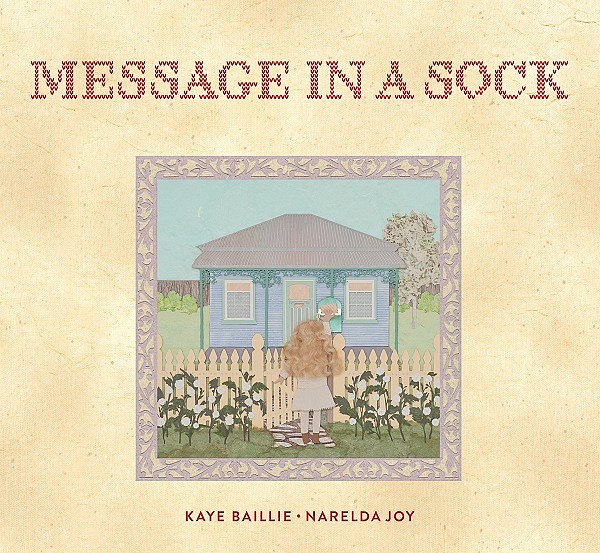
Message in a Sock by Kaye Baillie, illustrated by Narelda Joy and published by MidnightSun Publishing is a picture book that explores World War 1 from the perspective of those back home in Australia and is based on a true exchange between Lance Corporal A McDougall and a young girl.
The story begins with a call out for Australians to knit socks for the war chest with a request for 150 000 pairs for the soldiers in the trenches who were suffering trench foot due to the diggers immersed up to their knees in the wet, cold and slushy mud in the trenches.
Tammy’s father is serving in World War I. Tammy and her mother are very keen to help and contribute to the war effort. The mother spends every spare waking moment knitting warm socks and when they are complete Tammy washes them and together they press them. The socks are particularly long to protect the soldier’s feet and lower legs in their boots. Before they deliver ten pairs of socks to the War Chesty Depot Tammy and her Mummy write a message and Tammy includes this in the socks for her Dad. Each day she eagerly anticipates a reply.
A reply is forthcoming, is it from Tammy’s father or did another soldier receive the socks and message?
The detailed collage style illustrations build a picture of life at the time and give the reader an insight into the fashion and way of life (the astute reader will notice details like the fabric pieces in the girls hair when her Mummy is knitting by her bedside).
This story highlights the sense of pride and purpose that comes with being part of a collective effort that makes a difference. It shows that contributing and giving to a cause can help build community, connection and help deal with the tyranny of distance by supporting the soldiers from across the seas.
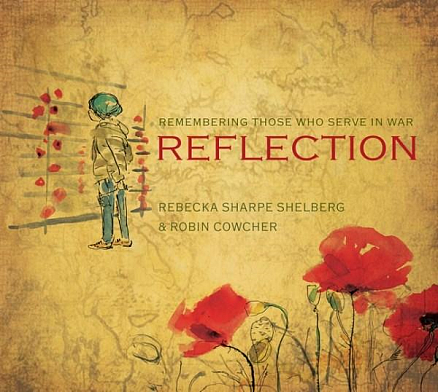
Reflection, Remembering Those Who Serve in War by Rebecka Sharpe Shelberg and illustrated by Robin Cowcher is a poignant and powerful story about remembrance ceremonies to honour those who have served, or are currently serving. This book explores the experiences that occur at a dawn service for Anzac Day, while simultaneously reflecting on Australia’s involvement in military campaigns.
From the very first double page spread the illustrations deftly show that this picture book contains two stories. It is interesting to note though, that the through the use of creative visual devices the illustrations merge into each other connecting a modern day remembrance Anzac Day ceremony to the past by juxtaposing scenes of Australian soldiers serving in Australia’s past military campaigns. Each illustration features a different conflict that Australians have served in, including the Boer War, World War I and World War II, the Korean War, the Vietnam War, both Gulf Wars, the War in Afghanistan and peace keeping missions in Bosnia and East Timor. The actions carried out by the family at the Anzac Day service reflect those of the soldiers on the opposite page.
The illustrations contain many opportunities to explore visual literacy. The images can be “read” like text from left to right to unpack the stories within them. There are certain events that commonly occur at Anzac Day services and have a symbolic meaning associated with them. Many of these have been included in the illustrations. On the first double page spread, a sprig of rosemary at the feet of the marching soldiers can be seen and is poignant as rosemary symbolises remembrance. Poppies feature several times throughout the story, this red flower has the rare ability to thrive on lands that are barren after being tumultuously disturbed, these flowers have become a symbol of sacrifice. There is a reference to The Last Post being played in the story, the bugle call to signify the end of the day for the soldiers.
At the end of the story information has been included about Australia and New Zealand’s experiences in military campaigns and peacekeeping missions. This story enables children to connect with Australia’s history in military campaigns in a highly accessible way. The text, coupled with the illustrations, also allows readers to come to learn about and appreciate why Remembrance Day services are observed, the common events that take place and the symbolism for remembrance services to honour the contributions and sacrifices made in the past and in present day missions.
